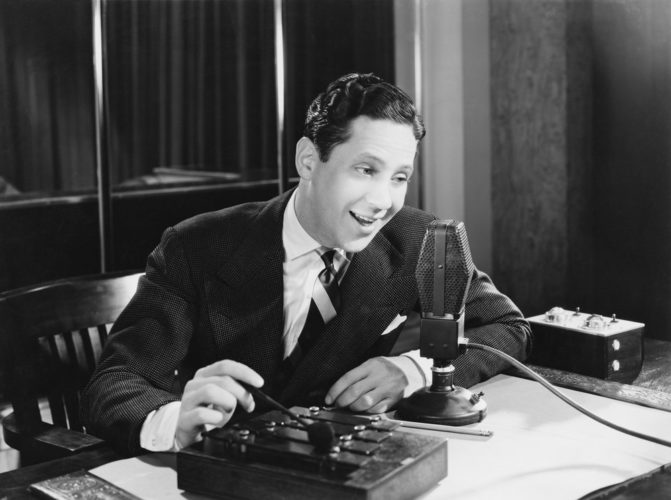We live in a day and age where it’s easy to take commonplace items for granted. After all, for most of us, electricity has always been around, and we can hardly recall the days when the internet wasn’t readily available.
Tools such as cameras and microphones are so normal these days, it’s hard to imagine that there was a time when we didn’t have this technology.
Before microphones, vocalists simply had to rely on their strength and the acoustic quality of their surroundings to project and be heard.
Of course, all performances were live. There was no way to record sounds, and furthermore, no one had the ability to play back recordings, even if they existed! In the same vein, journalists took notes by hand and printed via printing press. There was simply no way to share sound.
All of this changed in the late 1800s, with the invention of the microphone.
Not only did the microphone allow for the amplification of sound, but the actual transmission of sound in the first place. Suddenly, devices like the telephone, the paleophone, and the phonograph became possible. On their heels came radio broadcasting, “talkies”, and television.
Everything we know about sound today came from science that was developed as recently as the 19th century.
But who truly is responsible for the invention of the microphone? The history of the microphone is a fascinating look at how sound exists. In order for sound to be heard, it has to move, and that movement is what can be amplified.
Throughout the years, scientists have worked to harness the power of sound waves and improve the experience, through a series of really interesting experiments and inventions.
You’ll learn a lot about the origins, different derivations of the original sound technology, and who lays claim to the title of the inventor. In addition, you’ll understand what about the mic has made it stick around for so long.
Why Is It Called a Microphone?

We can thank Sir Charles Wheatstone for the term “microphone.” The word developed from two Greek terms: “mikros,” meaning “small, and “phone,” meaning “sound” or “voice.”
Together, we get “microphone,’ or “small sound.” When you consider how small the sound waves inside a microphone are, you realize how very accurate Sir Wheatstone was in his naming of the tool!
Sir Wheatstone was a prominent English physicist, and conducted a variety of experiments that helped us gain our current knowledge of how sound works.
He was raised by a family that manufactured musical instruments, and therefore was familiar with acoustic variations and sound-producing sources. In fact, one of his inventions was the concertina.
He discovered that sound is created by waves transmitting through a medium, and experimented with ways to amplify and transmit these sound waves.
He went on to invent the electric telegraph and the stereoscope, and his findings on the functions of sound and sound waves were the basis for all of the discoveries and inventions that led to the modern microphone.
The First Microphone Concept

The first instance of a microphone being employed specifically for the purpose of sound amplification and transmission is found in the Reis Telephone.
Born in Gelnhausen, Germany, Philipp Reis was obsessed with the quest to create an artificial ear. His experiments began in 1852, when he was just 18 years old. Reis built his inventions around knowledge of the anatomy of the human ear, as well as the findings of Sir Wheatstone.
His first attempts were primitive, yet effective, and he made use of objects that were readily available around the house. His first model included a violin case, a beer can, and a sausage casing!
As his experiments were refined, Reis learned that he would need to improve his microphone device in order to accurately transmit sound. As part of the Reis Telephone, his microphone included a parchment diaphragm and two brass strips on top of a closed wooden box, which had a speaking horn on one side of the box.
One brass strip was fitted with a drop of mercury and glued to the parchment. The other was mounted above that strip, and had a platinum contact that met the mercury droplet.
When sound entered the speaking horn, the sound waves would vibrate the parchment, and the two contacts would experience a variation in resistance.
That created the charge that would send an electrical signal through the box.
The Reis Telephone transmitted sound well, particularly music.
Unfortunately, spoken word included too many delicate variations in frequency, which made it difficult to understand.
While the first sentence spoken on this device is said to be “Das Pferd frisst keinen Gurkensalat,” it is possible that was a misunderstanding. (The statement is accurate, however: the horse does not eat cucumber salad.)
Early Types of Microphones
Once news of the Reis Telephone hit the scientific community, the race was on to create a better, more refined microphone that offered more power and better frequency response.
At this time, the market for microphones on their own was quite low; however, the idea of transmitting sound through a telephone, or being able to record and store sounds, was both astounding and promising.
The Liquid Transmitter, or “Water Microphone”
One of the first on the scene was Alexander Graham Bell, who invented the liquid transmitter, or “Water Microphone.” The technology associated with this device seems quite elementary by today’s standards, but it’s easy to see how Mr. Bell’s invention was premier at the time.
The Water Microphone was introduced in 1876, and as the name suggests, used water to transmit sound waves.
It was never very successful in its intended purpose, but this invention is credited as an inspiration in the field, as inventors furthered their work in the field of sound technology in order to invent something…anything!… that worked better than the Water Microphone!
This device gave inventors great insight into how microphone works and workings needed to be set up to allow sound waves to vibrate more accurately.
The transformer itself was a metal cup filled with water and sulphuric acid, which helped with electric conductivity. The diaphragm was stretched across a small horn, with a needle attached, which was also submerged in the liquid without touching the cup itself.
As sound vibrated against the diaphragm, the needle would vibrate within the water, causing the resistance within the water to fluctuate. A wire that was submerged in the liquid would then carry the resulting electric signal to a speaker.
The theory behind the Water Microphone was explained by Ohm’s law, which states that the current in a wire is inversely proportional to the resistance of the current.
While this particular model didn’t work quite as well as Bell anticipated, it served as the basis for many more experiments that would improve on the concept.
The Carbon Microphone
The Carbon Microphone was invented in 1876, under auspicious circumstances, which we’ll discuss in detail shortly.
This device was one of the most successful attempts at sound amplification, and had several of the advantages of modern microphones, such as high output, low impedance, and a reasonable cost to produce.
Of course, early models had limited frequency response, and thus low reproduction quality, but carbon microphones became the standard for telephones and radio broadcasting until the condenser microphone was invented in the 1920s.
Like the previous inventions, the carbon microphone uses variable resistance to manipulate sound waves into electrical audio signals.
The internal mechanism is comprised of two metal plates and carbon granules. Later models had a carbon button in between the plates instead of granules.
One of the metal plates is thick and stationary. The second plate is the diaphragm, and is thin and movable. As the sound waves vibrate the thinner plate, the sound pressure it places on the carbon in the middle varies.
The varied pressure causes the electrical resistance between the plates to change, as well, and when a direct current is applied to both plates, the variation in vibration creates the current that leads to the production of the audible voice.
At this point, science had an answer to the question “how does a microphone work,” and defined “what is a microphone.”
While there was still plenty of room for improvement, the basic mechanisms and concepts of these early microphones set the standards for the microphones we use today.
The War of the Patents

So to answer the question, “Who Invented the Microphone,” there are really several answers. On one hand, we can credit Philipp Reis with his work in creating a movable diaphragm that responded to vibrations.
Or perhaps it was Sir Wheatstone, as he explained how the concept would work in the first place. Alexander Graham Bell certainly had his part, as well, with the Water Microphone.
However, there was a bit of a tussle surrounding the official invention.
Thomas Edison and Emile Berliner are often credited with the creation of the carbon microphone. Edison is credited with creating a carbon telephone transmitter, as well as several follow up improvements, while Emile Berliner had a similar loose-contact transmitter in development simultaneously.
At the exact same time that Edison and Emile Berliner were preparing to debut their creations, David Edward Hughes was working on a nearly identical device.
Having previously invented the type-printing telegraph in 1855, Hughes was already a successful inventor when he developed a “carbon pencil” device that could amplify and transmit sound.
David Edward Hughes would never receive credit for his creation, however. Despite having invented the carbon microphone, Hughes did not patent his work, stating that the tool he dubbed a microphone was a “gift to the world.”
Meanwhile, Alexander Graham Bell purchased Berliner’s patent for a loose-contact microphone in 1878 as a way of improving the Bell telephone. The first Bell telephone used a liquid transmitter, and required modification for mass production.
By this time, Philipp Reis was already deceased, having passed away from tuberculosis in 1874. Bell’s work was deemed different enough from Reis’ invention to receive its own patent in 1876.
For a mere $50,000 (which is over a million dollars in today’s terms), Bell was able to purchase the patent to the microphone concepts created by Emile Berliner, and apply them to the telephone, allowing for improved sound quality and a more practical telephonic device.
Therefore, when Edison attempted to file patent for his version of the carbon microphone, a patent war ensued.
The case was taken to the United States Supreme Court, which ruled in 1892 that Edison had invented the microphone, and awarded him the patent.
Despite his contributions to the invention of the Water Microphone, Alexander Graham Bell was thus out $50,000 and a very successful patent.
In yet another turn of irony, it is said that Edison developed his carbon microphone from the work Bell exhibited with the Water Microphone, and borrowed some concepts directly from the Reis Telephone, as well.
So, while multiple inventors brought the microphone into existence, the credit goes to Thomas Edison, simply due to his keen timing in filing a patent and getting Americans excited about his product.
The Birth of the Modern Microphone

Inventions That Helped Create the Modern Microphone
As the fields of science and technology developed, relevant advances found their way into the microphone’s development, as well.
For example, the transformer was invented in 1885. With its ability to convert alternating current and direct current power supplies, it seems today like it would be an automatic addition to microphone technology. In reality, transformers were not incorporated until the 1920s.
Vacuum tubes, which are commonly used to temper microphone impedance and output issues, came along in the early years of the 20th century.
Sir John Ambrose Fleming, an early electrical engineer from England, invented the first vacuum tube in 1904. The very next year, Lee De Forest debuted the first triode vacuum tube, which is the basic version used in microphones today.
Magnets also came into play with the early models of our modern microphones, and the strong magnets we enjoy in dynamic microphones today weren’t readily available until the 1930s.
Together, all of these pieces came together to create a wave of inventions in the first half of the 20th century, all of which have led to the microphones we use and enjoy today.
The Condenser Microphone

In 1916, while working at the Western Electric company, an American physicist by the name of Edward Christopher Wente created the first condenser microphone.
This early model, designed at Western Electric, included two plates with an empty space between them, unlike the carbon buttons or fillings that were used in previous microphones.
One plate was the diaphragm, and was very thin to allow for vibrations when sound waves moved across its surface. The backplate was fixed and thick. A consistent level of voltage was added, allowing the plate to carry a fixed charge.
As sound waves vibrated the thinner plate, the plate moved, changing the distance between the two plates, thus (in the simplest of terms) creating the necessary charge for the movement of sound.
Wente’s invention requires an impedance converter to create a sturdier sound with greater signal current and less outside interference, but had some of the best levels of sensitivity and response.
In 1928, George Neumann made the CMV3 microphone, affectionately known as “The Bottle,” the first condenser microphone available to the commercial market.
The Moving Coil Microphone
The Moving Coil microphone is a common fixture today, but was actually invented several times.
First, the prominent German engineer and inventor Ernest Werner von Siemens presented a prototype in 1877. Unfortunately, magnets with enough power to allow this microphone to work properly were not available at the time.
Next, Captain Henry Joseph Round, who was chief engineer at Marconi, created the Marconi-Sykes magnetophone in 1923.
This version included a paper diaphragm, an oddly-shaped magnet, an iron pot, aluminum wire, and cotton wool pads with a rubber solution. The signals were forced through transformers and vacuum tubes, to create a strong audio signal.
This primitive version was replaced by our modern moving-coil dynamic microphone in 1931, courtesy of Edward C. Wente and Albert L. Thuras, a pair of American scientists. They improved upon the method with polystyrene components, and a conductive coil, along with stronger magnets.
The Ribbon Dynamic Microphone, And The Electret Microphone
The Ribbon Dynamic Microphone, which harnesses the power of electromagnetism in full, was invented in 1924 by a pair of German scientists.
Walter Hans Schottky and Dr. Erwin Gerlach created a microphone with a fine conductive ribbon, hence the name. This ribbon is comprised of very thin aluminum, and is encased in a magnetic structure. The ribbon then acts as a diaphragm to create the AC audio signal.
Much like the condenser and coil microphones, it wasn’t until the 1930s that the ribbon microphone became practical for broadcasting and other audio productions, as the magnets simply weren’t powerful enough to move the current.
In 1931, the first commercially available version of the ribbon microphone, designed by Harry F. Olson of the RCA company, was released in a very limited run. Only 50 RCA PB-31 mics were released, but the design soon took hold.
Of course, in 1964, Bell Laboratories… and in-particular, two researchers by the names of Gerhard Sessler and James West… received a patent for an electroacoustic transducer… also known as the electret microphone.
The invention of the electret microphone truly revolutionized microphone technology, and led to upgrades in microphones that greatly enhanced their performance overall.
In Conclusion
So who invented the microphone, and what is microphone history really about? Any one of the esteemed inventors above could be considered the “Father of the Microphone,” if we consider his or her contributions to the development of audio technology.
While each individual mic manufacturing company can lay claim to their own developments and advances, it’s hard to say that any one individual is responsible for the invention.
Naturally, Thomas Edison receives ultimate credit, based on the timing of his patent, but without the research and discoveries of Sir Wheatstone, the experiments and understanding of the human ear gleaned from Philipp Reis, and the spectacular failure of the Water Microphone, Edison is obviously in very good company among inventors who have tried to improve upon acoustic technology.
